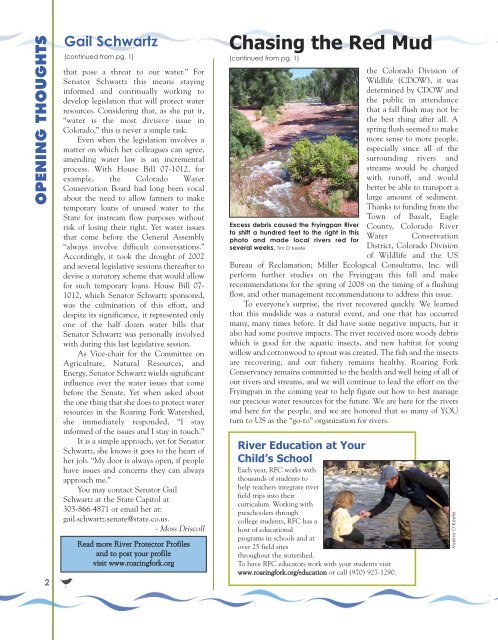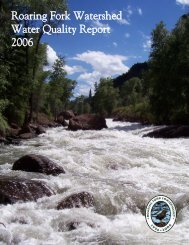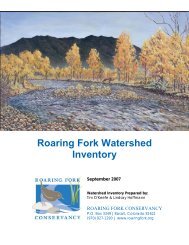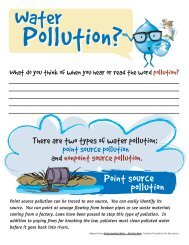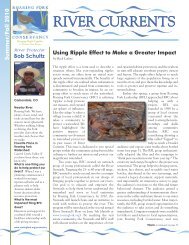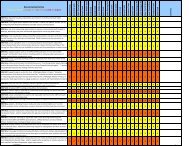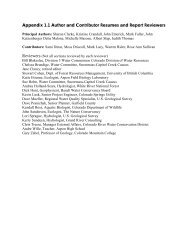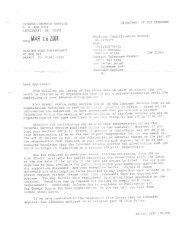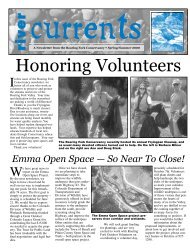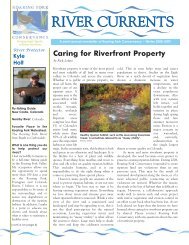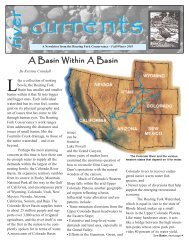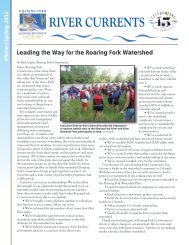Winter 2007 - Roaring Fork Conservancy
Winter 2007 - Roaring Fork Conservancy
Winter 2007 - Roaring Fork Conservancy
Create successful ePaper yourself
Turn your PDF publications into a flip-book with our unique Google optimized e-Paper software.
2OPENING THOUGHTS<br />
Gail Schwartz<br />
(continued from pg. 1)<br />
that pose a threat to our water.” For<br />
Senator Schwartz this means staying<br />
informed and continually working to<br />
develop legislation that will protect water<br />
resources. Considering that, as she put it,<br />
“water is the most divisive issue in<br />
Colorado,” this is never a simple task.<br />
Even when the legislation involves a<br />
matter on which her colleagues can agree,<br />
amending water law is an incremental<br />
process. With House Bill 07-1012, for<br />
example, the Colorado Water<br />
Conservation Board had long been vocal<br />
about the need to allow farmers to make<br />
temporary loans of unused water to the<br />
State for instream flow purposes without<br />
risk of losing their right. Yet water issues<br />
that come before the General Assembly<br />
“always involve difficult conversations.”<br />
Accordingly, it took the drought of 2002<br />
and several legislative sessions thereafter to<br />
devise a statutory scheme that would allow<br />
for such temporary loans. House Bill 07-<br />
1012, which Senator Schwartz sponsored,<br />
was the culmination of this effort, and<br />
despite its significance, it represented only<br />
one of the half dozen water bills that<br />
Senator Schwartz was personally involved<br />
with during this last legislative session.<br />
As Vice-chair for the Committee on<br />
Agriculture, Natural Resources, and<br />
Energy, Senator Schwartz wields significant<br />
influence over the water issues that come<br />
before the Senate. Yet when asked about<br />
the one thing that she does to protect water<br />
resources in the <strong>Roaring</strong> <strong>Fork</strong> Watershed,<br />
she immediately responded, “I stay<br />
informed of the issues and I stay in touch.”<br />
It is a simple approach, yet for Senator<br />
Schwartz, she knows it goes to the heart of<br />
her job. “My door is always open, if people<br />
have issues and concerns they can always<br />
approach me.”<br />
You may contact Senator Gail<br />
Schwartz at the State Capitol at<br />
303-866-4871 or email her at:<br />
gail.schwartz.senate@state.co.us.<br />
- Moss Driscoll<br />
Read more River Protector Profiles<br />
and to post your profile<br />
visit www.roaringfork.org<br />
Chasing the Red Mud<br />
(continued from pg. 1)<br />
Excess debris caused the Fryingpan River<br />
to shift a hundred feet to the right in this<br />
photo and made local rivers red for<br />
several weeks. Tim O’Keefe<br />
the Colorado Division of<br />
Wildlife (CDOW), it was<br />
determined by CDOW and<br />
the public in attendance<br />
that a fall flush may not be<br />
the best thing after all. A<br />
spring flush seemed to make<br />
more sense to more people,<br />
especially since all of the<br />
surrounding rivers and<br />
streams would be charged<br />
with runoff, and would<br />
better be able to transport a<br />
large amount of sediment.<br />
Thanks to funding from the<br />
Town of Basalt, Eagle<br />
County, Colorado River<br />
Water Conservation<br />
District, Colorado Division<br />
of Wildlife and the US<br />
Bureau of Reclamation; Miller Ecological Consultatns, Inc. will<br />
perform further studies on the Fryingpan this fall and make<br />
recommendations for the spring of 2008 on the timing of a flushing<br />
flow, and other management recommendations to address this issue.<br />
To everyone’s surprise, the river recovered quickly. We learned<br />
that this mudslide was a natural event, and one that has occurred<br />
many, many times before. It did have some negative impacts, but it<br />
also had some positive impacts. The river received more woody debris<br />
which is good for the aquatic insects, and new habitat for young<br />
willow and cottonwood to sprout was created. The fish and the insects<br />
are recovering, and our fishery remains healthy. <strong>Roaring</strong> <strong>Fork</strong><br />
<strong>Conservancy</strong> remains committed to the health and well being of all of<br />
our rivers and streams, and we will continue to lead the effort on the<br />
Fryingpan in the coming year to help figure out how to best manage<br />
our precious water resources for the future. We are here for the rivers<br />
and here for the people, and we are honored that so many of YOU<br />
turn to US as the “go-to” organization for rivers.<br />
River Education at Your<br />
Child’s School<br />
Each year, RFC works with<br />
thousands of students to<br />
help teachers integrate river<br />
field trips into their<br />
curriculum. Working with<br />
preschoolers through<br />
college students, RFC has a<br />
host of educational<br />
programs in schools and at<br />
over 25 field sites<br />
throughout the watershed.<br />
To have RFC educators work with your students visit<br />
www.roaringfork.org/education or call (970) 927-1290.<br />
Marina O’Keefe


